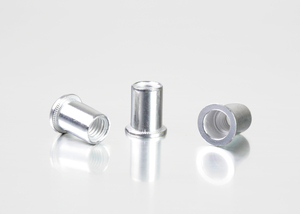Blog Information
- Posted By : haining khfastener
- Posted On : Nov 02, 2020
- Views : 493
- Category : General
- Description : The common forms of riveting nuts include pressure riveting nut column, expanding riveting nut, pulling riveting nut, and floating riveting nut.
Overview
The common forms of riveting nuts include pressure riveting nut column, expanding riveting nut, pulling riveting nut, and floating riveting nut.
(1) Pressure riveting nut column
Squeezing riveting refers to the plastic deformation of the base material under external pressure during the riveting process, and squeezing into the riveting screw and the prefabricated groove in the nut structure to achieve a reliable connection of the two parts. There are two types of non-standard nuts for pressure riveting, one is the pressure riveting nut column and the other is the pressure riveting nut.
This riveting form is used to realize the connection with the substrate. This riveting form usually requires the hardness of the riveted parts to be greater than the hardness of the substrate. Common low-carbon steel, aluminum alloy plates, and copper plates are suitable for crimping and riveting nut posts. For stainless steel and high-carbon steel plates because the material is hard, special high-strength pressure riveting nut columns are required. Not only are the prices high, but the crimping is difficult, the crimping is not reliable, and the crimping is easy to fall off after crimping. The manufacturer ensures reliability , It is often necessary to add welding below the side of the nut post, which is not good in manufacturability. Therefore, the sheet metal parts with pressure riveting nut posts and pressure riveting nuts should not be made of stainless steel as much as possible, including pressure riveting screws and pressure riveting nuts. , Not suitable for use on stainless steel plates.
(2) Riveting nut
Riveting refers to the way in which part of the material of the riveted screw or nut undergoes plastic deformation under the action of external force and forms a tight fit with the base material during the riveting process, thereby achieving a reliable connection of two parts.
The riveting process is relatively simple, and the connection strength is relatively low. It is usually used in situations where the height of the fastener is limited and the torque is not large.
(3) Blind rivet nuts
Blind riveting refers to the plastic deformation of the riveted part under the action of external tension during the riveting process. The deformation position is usually in a specially designed position. The deformed part clamps the base material to achieve a reliable connection. The commonly used rivet nut is This type of riveting is used to realize the connection with the substrate.
Pull riveting uses a special riveting gun for riveting, and it is mostly used in situations where the installation space is small and general riveting tools cannot be used, such as closed pipes.
(4) Floating pressure riveting nut
For some riveting nuts on sheet metal structures, because the overall auspicious structure is complex, the cumulative error of the structure is too large, so that the relative position error of these riveting nuts is very large, causing other parts to be difficult to assemble, so use the corresponding pressure riveting nut position After pressure riveting floating nuts, this situation is improved.
For more details, please contact:Rivet Nut Aluminium
